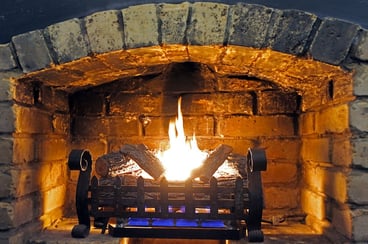 As we move into the closing months of the year, the weather begins to cool, the leaves turn color, football games get more intense, and we start preparing for winter. One of the items to prep for the changing season is having your fireplace ready. It is time to make sure your gas logs are up to the task of providing warmth for your family, and that comforting glow that comes with the season. But before you change out your gas logs, it is important to know the difference between a vented and a vent-free gas log.
As we move into the closing months of the year, the weather begins to cool, the leaves turn color, football games get more intense, and we start preparing for winter. One of the items to prep for the changing season is having your fireplace ready. It is time to make sure your gas logs are up to the task of providing warmth for your family, and that comforting glow that comes with the season. But before you change out your gas logs, it is important to know the difference between a vented and a vent-free gas log.
First of all, it is important to know that vented and vent-free gas logs are not the same thing. Their differences may go a long way in helping you decide which type is the better fit for your home.
The biggest difference between the two is that with vented logs, you have all the elements of a real fire. The flame from the gas hits and goes through the vented logs, heating them quickly and more efficiently than vent-free logs. When lit, the way the vented logs burn and glow more accurately resembles a wood fire. Flames rise like they do off of wood. They also have that natural yellow-to-orange color that you see with wood. Vent-free gas logs generally have a lower flame that has a less robust look to it. The flames don’t actually touch the logs, which means you are just burning gas, which tends to result in more blue flames showing up with the yellow.
The next difference between the two is the amount of heat generated. Some people will tell you that you get more heat from a vent-free system because, with a vented system, you need to have a chimney. Their argument is that having an exhaust port like a chimney means heat is escaping, but the amount of heat generated with a vented system is far superior to the vent-free system. The vent-free system is essentially a modernized version of the 1950s gas space heater. Since the flame in a vent-free system can’t touch the logs, they take longer to heat. Also, since they are fiber logs, they don’t radiate and amplify the heat. They are simply there for show while the gas does all the work.
Plus, since all fires need oxygen to burn, the vented system literally has a built-in advantage. The chimney, while allowing for exhaust, is also allowing for oxygen to fuel the fire. In a vent-free system, they use the oxygen that is in the room. This won’t normally pose a problem if you are using them in an outdoor fireplace, but if they are in a closed room, you should be aware of it. But, you will need a CO2 detector to tell you if the levels in your home aren’t where they need to be. If the oxygen levels get low, you will need to open a window to offset it, meaning you will lose more heat than you will through the chimney.
Another difference between a vented and a vent-free system is cleanliness. With a vent-free system, the smell of the gas is much more likely to linger than it is with a vented system where any odor from the gas escapes through the chimney. Also, vent free systems are also known to create moisture, which can lead to mold.
As with most things in your home, whether you’re talking about an indoor or outdoor fireplace, it all comes down to personal preference and working with what you’ve got. If your home was built with a vent-free system, you would need to do some major work to switch to a vented system. However, if you are open to either and want the look of a real wood-burning fire, vented gas logs are right for you. Fortunately, at Casual Creations, we have a wide selection of both varieties for your consideration.



